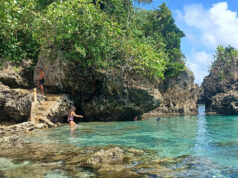FROM OUR ARCHIVES: Open exhibit shows the playful side of Napoleon Abueva
BusinessWorld, Arts & Leisure
November 15, 2006
By Anna Barbara L. Lorenzo
One enjoys a different feeling when sitting around the Ayala Museum Plaza these days.
Aside from the usual concrete structures, one can opt to wait for a rendezvous while sitting on benches scooped out of hardwood and contemplating the intricacies of a marble or a bronze sculpture just a few feet away.
One can even sit alongside a nude woman, only she is made of fiberglass with a bronze finish. And she is faceless.
Various works by National Artist Napoleon V. Abueva are currently on display at the plaza of the Ayala Museum in an exhibit called Credo, which runs until Nov. 26. It features various artistic and functional pieces that reflect Mr. Abueva’s personal beliefs.
Highlighting the collection is The Deposition, a 10-foot tall relief carved in white marble. The sculpture depicts Jesus Christ as he was being taken down the cross by three men, with Mother Mary holding his foot and Mary Magdalene reaching out to him.
“This is just my concept. It shows that after the crucifixion, he was brought down from the cross. There are very few interpretations like this, unlike the crucifixion,” Mr. Abueva said.
The artist started working on the two-ton piece of marble from Volkos, Greece, in January through a grant from the National Commission for Culture and the Arts.
Credo is also a testament to Mr. Abueva’s versatility as a sculptor as it shows pieces in metal, steel, hardwood, fiberglass.
While most of the pieces seem very formal and religious, the Credo collection also shows the public that even at 76, Mr. Abueva still has a playful and humorous take on his works.
On one stretch of narra wood, Mr. Abueva sculpted images of the saints getting drunk over the celebration of the Intramuros wall restoration.
There is also the inviting faceless woman sitting on a bench, titled Please Sit Pretty Close to Me. Anyone can sit and pose for a photo with the figure. After all, Mr. Abueva said he made it faceless so it can be anybody for whoever sits with it.
In one corner of the Ayala Museum’s plaza sits what seems like an ordinary chair made extraordinary by its long arms.
“This is sometimes called the impolite chair,” Mr. Abueva said with a smile. “It is for the friars in the Spanish time. It has long arms so they can put up their legs while scratching their big bellies.”
Another pretty unusual yet functional piece is the catapult. Mr. Abueva said he used to play with it with his grandchildren, placing candies instead of stones which are thrown up to the air.
“It is part of my personality. I like movements and playful aspects,” Mr. Abueva said.
As a child of Bohol, the artist also wants to create an outdoor museum overlooking the popular Loboc River to provide tourists and locals with an exposure to local arts.
As National Artist, Mr. Abueva wants to further spread awareness on Philippine sculpture by creating what is similar to the sculpture gardens in Japan and Sweden.



